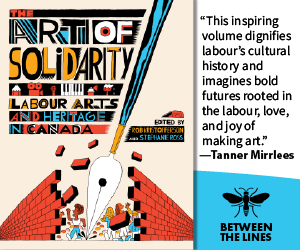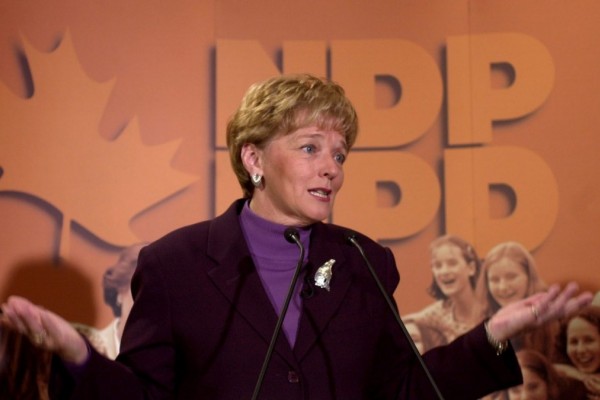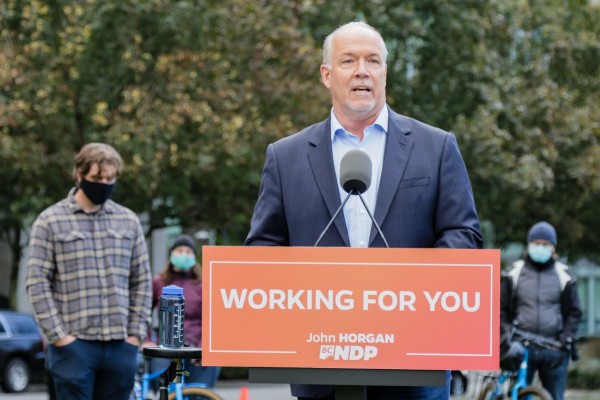What I learned about managing media in the 2022 ONDP campaign
Tom Parkin spent five weeks embedded in the ONDP campaign. His take on why Andrea Horwath and her party fell short

Former Ontario NDP leader Andrea Horwath mingles with local residents at a campaign stop in Belleville. Photo by Nicole Kleinsteuber/InQuinte.ca.
Back on January 13, then-leader of the Ontario NDP, Andrea Horwath, teamed up with Ontario Nurses Association President Catheryn Hoy to warn Ontarians that 20,000 more nurses must be hired to avoid a health care crisis.
Data from recruitment company HHR showed that in October 2021, 8.1 percent of hospital jobs were unfilled, up from 3.7 percent in March 2019. Meanwhile, hospitals saw a job vacancy rate of 8.9 percent in March 2022. This rose to 12.6 percent for registered nurse positions.
Whatever data Horwath and Hoy were working from, there’s little doubt Doug Ford had more. Before their 2018 defeat, the Ontario Liberals had significantly defunded health care. Then the PCs continued to cut. The Ford government’s 2022 budget—re-tabled recently—calls for $2.7 billion in unspecified cuts and plans for health spending to fall further behind inflation, let alone population growth.
Now, as emergency rooms clog up, ambulance response times grow and emergency room waits hit new records, the crisis is boiling over. Looking back, it’s hard to believe health care understaffing received so little attention during the recent Ontario election campaign.
Hospitals are understaffed and overrun. Health care heroes are burnt out and thousands have left their jobs. We can do so much better.
— Andrea Horwath (@AndreaHorwath) January 13, 2022
Today @OntarioNurses President Cathryn Hoy and I shared a plan to tackle the nursing shortage and support hospitals. Let's get it done. #ONpoli pic.twitter.com/34tqdQABkR
Indeed, health care staffing woes was a key message of Horwath’s campaign, and this became more pronounced as the election drew to a close. Daily, NDP campaign press releases cited the specific number of additional personal support workers, nurses and doctors needed in each community the tour was visiting.
Four days before Ontarians headed to the polls, Horwath and Hoy again hosted a media event to ring the alarm. The Queen’s Park press gallery was invited to attend—and many reporters did. Yet, to this day, I have been unable to find a single reference to the warnings raised that morning by Hoy or Horwath by any press gallery reporter who was present at the event.
Rather than cover warnings of the impending hospital understaffing crisis, the Canadian Press ran with a story quoting a pollster who argued voters were apathetic about the campaign.
It wasn’t just health care. Earlier in the campaign, Horwath announced a plan to fundamentally change Ontario’s auto insurance system, including a public sector takeover of at least a segment of the industry. The New Democrats expected media pushback and questions about former NDP Premier Bob Rae’s reversal on the issue. They thought there would be media reaction to the eye-popping promise of cutting insurance rates by as much as 40 percent. But they didn’t get pushback or reaction. In fact, they barely got a question.
Some will be quick to blame the media. Of course there are many—particularly right-wing opinion columnists—whose loathing for the NDP is clear. But media bashing is both wrong and unhelpful. The challenge for campaigns is to play to the dynamics shaping reporting as strongly as possible in order to advance a party’s preferred issues. But as in any card game, not every hand holds winning cards. And during the 2022 campaign, the NDP held a dud hand.
Historically, the focal point of campaign media relations was the tour bus. Political parties provided seats for journalists and outlets assigned a reporter to travel with the campaign, switching up assignments at week’s end. On-tour communications staff played a key role in schmoozing and pitching reporters throughout their stay.
The pandemic changed that. While, as in the past, local reporters joined local tour events in-person, during the 2022 campaign, Queen’s Park press gallery reporters almost always joined by video teleconference (mostly Zoom). Their reporting assignments usually changed by the day, rather than each week. In 2022, the Liberals and the PCs didn’t provide media seats on their tour. The NDP did, but very few took up the offer.
The shift to Zoom meant campaigns’ on-tour communications staff played a smaller role interacting directly with reporters while headquarters-based communications staff played a bigger one. This meant in-person communication was diminished while over-the-phone chats increased. This undeniably affected reporting.
Without a doubt, Zoom coverage directly accelerated the trend away from reporting each campaign’s announcements and toward covering more dramatic inter-campaign dynamics. In previous campaigns, with a reporter assigned to each bus, there would be reports from two or three campaigns each day. Under that model, the challenge for the NDP was to be at the centre of one of those reports. But through Zoom, a single reporter could join all three leaders’ events, anywhere in the province, then write a single round-up piece on all three campaigns that day.
A round-up report outlining each leader’s announcement would feel disjointed and rambling. For the story to work, it needs a single thread on the campaign’s dynamics, linking and contrasting each party’s efforts.
The focus on campaign dynamics was also pushed by an increase in collaborative reporting assignments. The Toronto Star commonly ran daily stories with bylines from three reporters, each assigned to a different campaign for the day. The Canadian Press appeared to coordinate its reporters to have them ask each leader about the same issue. The leaders’ responses were then consolidated into a single story. Both these models pushed away from reporting on leaders’ announcements and toward covering and emphasizing inter-campaign dynamics.
This trend isn’t necessarily a bad thing. At its best, political reporting focused on dynamics between campaigns would cover the cut and thrust of duelling political visions, platforms and characters. But, if that high-level conflict is not available, journalists need to settle for reports about polls, spin, secondary stories and scandal. And that conflict was not available in 2022—some of it by design.
I’ve argued elsewhere that the NDP’s problem wasn’t its campaign; it was getting to the starting line third in province-wide polling. While closer to election day it became clear the NDP had always been ahead of the Ontario Liberals where it counts—in seats—that public realization came too late, leaving no time to pose a challenge to Ford. No challenge meant no conflict. And when media coverage is increasingly about dynamics, no conflict means no reporting. No one wants to read (or write) a news report about the sound of one hand clapping.
Meanwhile, the Ford team designed their campaign to avoid any conflict that could attach to them. Ford held a few rallies, each featuring a presentation of less than 10 minutes. Several PC campaign events were even cancelled on short notice. And where Ford did appear for media events, he said little and took few questions. Ultimately, the Ford PCs threw a wet blanket over their campaign, further starving reporters of high-level conflict.
With Horwath unable to create conflict and Ford withdrawing from it, the only remaining campaign dynamic was the dispiriting battle between Horwath and Liberal leader Stephen Del Duca, which was presented as “the fight for second place.”
The exception in the trend toward reporting campaign dynamics appeared to be in local reporting. In contrast with Ford, who avoided all media (and Del Duca), the Horwath campaign often ran four or more tour stops a day trying to optimize local media coverage.
When a leader’s tour is in town, local news will report on just one campaign—the one in their community. Unlike press gallery reporting, local reporting will focus on the leader’s announcement and less on campaign dynamics. Local media was effective for getting the NDP’s message out. But the tour can’t be in every town on every day.
The media tour bus is probably dead and the trend toward Zoom coverage is likely here to stay. That probably means round-up reports will continue to dominate press gallery writing. That doesn’t mean campaigns won’t debate and explore key issues facing voters. But that is determined by the campaigns, not reporters.
Had Horwath posed a real challenge to Ford or had Ford stumbled rather than disengaged, the same platforms and leaders could have generated exciting conflict between campaigns. In turn, reports on inter-campaign dynamics would have brought forward the issues and contrasts for voters to see.
Unfortunately, that was not the case during the 2022 Ontario election. Cathryn Hoy’s late campaign intervention would have been great for health reporters, but it lacked the necessary ingredient of political reporting. The result was that critical alarm bells weren’t heard while critical issues weren’t debated. And now, understaffed emergency rooms are closing and some people are surprised.
Tom Parkin is principal of Impact Strategies and worked with the Ontario NDP 2022 campaign media management team.










